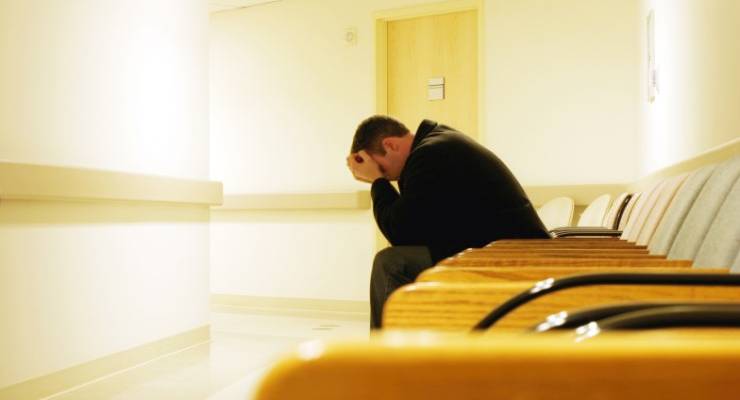
Research released this week has tracked a marked increase in severe psychological stress among Australians during the COVID-19 pandemic.
Mental health experts argue flattening the curve of mental health-related deaths is just as important as flattening the curve of the coronavirus — however rhetoric surrounding COVID-19 deaths versus post-pandemic mental health deaths is starkly different.
COVID-19 modelling by Melbourne University’s Doherty Institute has been described by Prime Minister Scott Morrison as “a useful tool” to “inform Australian governments”, whereas mental health impact and suicide modelling by Sydney University’s Brain and Mind Centre has been called “unwarranted” by recently-appointed deputy chief medical officer for mental health Ruth Vine.
Those behind the mental health modelling have called the government’s approach dismissive — though others warn the rhetoric around suicide could be harmful.
An extra strain
Research from ANU found that between February and April the amount of 18 to 24 year olds experiencing severe psychological stress increased from 14% to 22.3%. For 25 to 34 year olds, the figure climbed from 11.5% to 18%.
Mental health hotlines have seen a spike in calls, with a four-fold increase in people contacting Beyond Blue.
Meanwhile, modelling from Sydney University has found there may be a 25 to 50% increase in suicide — up to 1500 additional deaths annually — disproportionately affecting young people.
But modelling by the same team also shows holistic intervention in mental health services could reduce this number by 8 to 10%.
Co-director of the Brain and Mind Centre Ian Hickie told Crikey the same commitment to the economy and the population’s physical health was not being applied to mental health.
“We have very strong dynamic statistical models, we have historical evidence,” he said. “Systems were heading in the wrong direction even before COVID-19.”
Inadequate investment
The federal government has announced $48.1 million in additional funding for the National Mental Health and Wellbeing Pandemic Response Plan.
$10.4 million of this is going toward a national “it’s okay to not be okay” awareness campaign, $7.3 million toward research and data collection, and $29.5 million toward reaching out to vulnerable groups.
But, Hickie argued, these grants do little to bolster mental health services on the ground. “What’s the point in making people aware they need help when just one in six people with depression get effective treatment?” he said.
“We need specialised care outside hospitals, we need aftercare, team-based supports, and IT-coordinated, digital support program care.”
Instead of investing in research and campaigns, Hickie argues the government should purchase private hospital services for mental health, as it did in preparation for COVID-19.
“Flattening the coronavirus curve was about not having the health system overwhelmed,” he said. “How is death from suicide different from death from COVID-19 if it has the same preceding factors?”
Language matters
Senior Research Fellow at Melbourne University’s School of Population and Global Health Dr Gregory Armstrong told Crikey some of the media coverage on mental health impacts had been concerning.
“Coverage has frequently used sensational terminology like epidemic, surge, tsunami, when we could simply be talking about our legitimate concerns regarding suicide rates,” he said.
Armstrong warned using sensationalist imagery heighten fears, but also risks normalising suicide. He said it was a particular risk if it is linked to a single cause people can identify with, such as unemployment.
“The coverage has often presented increases in suicides as somewhat inevitable, which strikes me as an unhelpful message to send to people in the community who may themselves be in distress. The outcomes here are far from predictable and suicide is never inevitable,” he said.
Professor Nicholas Procter, leader of the Mental Health and Suicide Prevention Research Group at the University of South Australia, told Crikey language matters when it comes to mental health.
“In suicide prevention, advocates say we have to be cautious around the use of language because it can be triggering to vulnerable groups who don’t have the same protective barriers others have,” he said.
Vulnerable groups, including people who have survived trauma or experience mental illness, can have two reactions to discussions of suicide, he said.
“You can have an unwanted contagion effect or a Papageno effect,” he said. In the contagion effect, a word or topic can act as a negative trigger, whereas with the Papageno effect, having dialogue out in the open can serve as a positive trigger, normalising the issue and prompting a person to get help.
The evidence around what causes which response is mixed, Procter said. “We don’t know for sure … it’s an important discussion we have to have and as we progress, we have to find a common ground and have experts come together.”
For anyone seeking help, Lifeline is on 13 11 14 and Beyond Blue is 1300 22 4636.








Crikey is committed to hosting lively discussions. Help us keep the conversation useful, interesting and welcoming. We aim to publish comments quickly in the interest of promoting robust conversation, but we’re a small team and we deploy filters to protect against legal risk. Occasionally your comment may be held up while we review, but we’re working as fast as we can to keep the conversation rolling.
The Crikey comment section is members-only content. Please subscribe to leave a comment.
The Crikey comment section is members-only content. Please login to leave a comment.